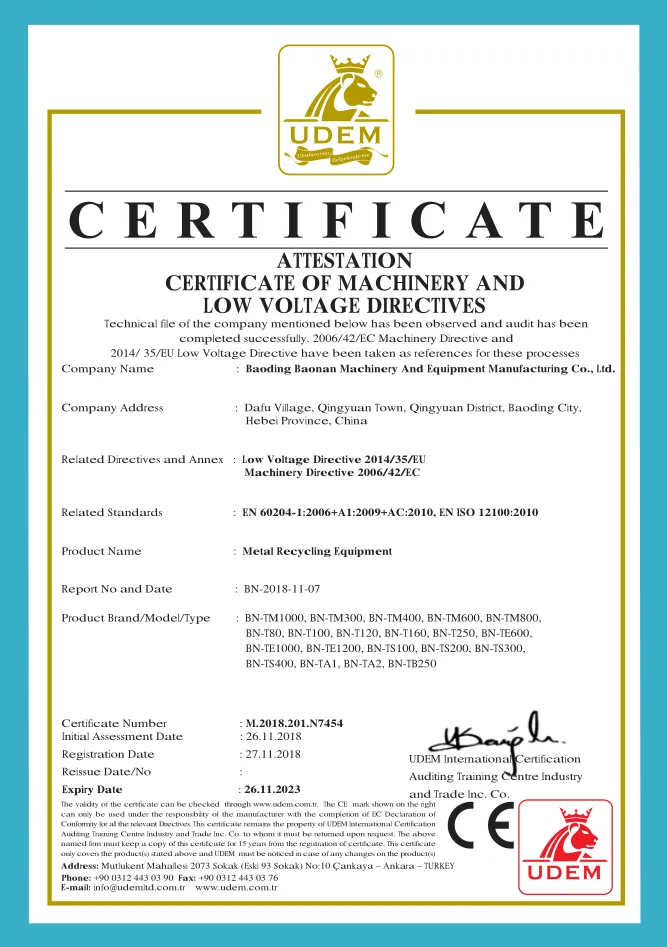

نويابىر . 26, 2024 23:50 Back to list
Understanding Industrial Shredder Machines An Essential Tool for Waste Management
In today's fast-paced industrial environment, the importance of efficient waste management cannot be overstated. As industries continue to expand, the need for effective solutions to handle waste materials becomes critical. Among the various tools available for this purpose, industrial shredder machines stand out as essential devices designed to streamline the process of reducing various types of waste into manageable sizes.
What is an Industrial Shredder Machine?
An industrial shredder machine is a heavy-duty machine designed to reduce large, bulky materials into smaller pieces. These machines can process a wide variety of materials, including metals, plastics, paper, rubber, and electronic waste. The shredding process not only makes it easier to manage waste but also prepares materials for recycling and repurposing, contributing to a more sustainable environment.
Types of Industrial Shredders
There are several types of industrial shredders, each designed to meet specific needs and applications
1. Single-Shaft Shredders These shredders use a single rotor and a fixed stator blade to process materials. They are particularly effective for shredding plastic, wood, and other softer materials.
2. Dual-Shaft Shredders Featuring two counter-rotating shafts, these machines are capable of shredding thicker and tougher materials. They often have greater torque and can handle a wider range of materials, including metals.
3. Granulators Although technically different from industrial shredders, granulators are often used in conjunction with shredders. They are designed to create uniform particle sizes and are commonly used in the recycling of plastics.
4. Heavy-Duty Shredders These are large machines designed to handle extreme volumes of heavy and tough materials, such as construction debris or industrial waste.
The Shredding Process
The shredding process typically involves several stages

1. Feeding Waste materials are fed into the shredder through a hopper. Depending on the machine's design, this could be done manually or automatically.
2. Shredding The materials are then shredded by rotating blades. The size of the shredded output can often be adjusted by changing the blade configuration or using screens.
3. Discharge Once the materials are shredded to the desired size, they are discharged from the machine for further processing or disposal.
Benefits of Using Industrial Shredder Machines
1. Reduction of Waste Volume One of the primary benefits of industrial shredders is their ability to significantly reduce the volume of waste materials. Shredding can reduce the size of bulky items, making them easier to handle and transport.
2. Facilitation of Recycling By breaking down materials into smaller pieces, shredders enable easier recycling processes. Many recycling facilities require materials to be shredded to optimize the sorting and processing phases.
3. Improved Safety Handling large, unsorted waste can pose safety hazards to workers. Shredders minimize these risks by ensuring that materials are managed in a more uniform and controlled manner.
4. Cost-Effectiveness Investing in an industrial shredder machine can lead to long-term cost savings. By reducing waste volume, companies can lower disposal costs, enhance recycling efforts, and potentially recover valuable materials for resale.
5. Environmental Benefits The use of industrial shredders contributes to a more sustainable waste management approach. By facilitating recycling and reducing landfill waste, these machines play a significant role in promoting environmental responsibility.
Conclusion
As industries continue to grow and evolve, the need for efficient, effective waste management solutions will only increase. Industrial shredder machines serve as vital tools in this landscape, offering benefits that extend beyond simple waste reduction. By investing in the right shredding technology, companies can enhance their operational efficiency, abide by environmental regulations, and contribute to a sustainable future. As we move forward, the role of industrial shredders will undoubtedly become more critical in our efforts to manage waste responsibly and recycle materials effectively.
Latest news
eddy-separator-for-non-ferrous-metals
NewsAug.22,2025
e-waste-bin-for-collected-spray-cans-sustainable-disposal-solutions
NewsAug.22,2025
dual-shaft-shredder-with-adjustable-blade-gaps
NewsAug.22,2025
hammer-crusher-machine-with-secondary-crushing
NewsAug.22,2025
copper-granulator-our-promise-of-recycling-excellence
NewsAug.22,2025
industrial-shredders-crafted-for-e-waste-recycling
NewsAug.22,2025